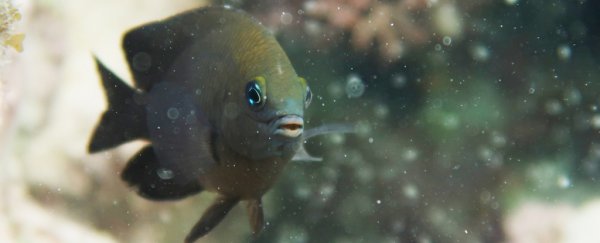Whether it's our canine best friends or ambivalent feline housemates, humans are indisputably the best at domestication.
The list of species we've domesticated ranges from dogs, sheep, and chickens, to more elusive creatures like bees and parrots, plants like wheat and corn, and even ourselves. Now, researchers have discovered fish that seem to be using shrimp in the same way we would use a farm animal.
The team thinks it could be the first example of a vertebrate species - other than human - domesticating another animal.
The farmer fish in question is called a longfin damselfish (Stegastes diencaeus), and they spend their days amongst the coral reefs off the coast of Belize, in Central America, tending to and munching on their own personal algae farms.
They're also pretty proud of their produce, and will chase away any creatures that get too close – except for swarms of tiny zooplankton called mysid shrimps (Mysidium integrum) who are seemingly 'fertilising' the algae patch.
"The damselfish aggressively defend a patch of reef where they farm algae for food, against all but the mysid shrimps," explains Deakin University ecologist Rohan Brooker.
"Swarms of the mysid shrimp, who benefit from the protective refuge provided by damselfish, fertilise the algal farms with their waste, improving quality of the farmed algae, and in turn, the condition of the farmer, the damselfish."
The idea is that the damselfish and mysid shrimp started off in a commensal relationship where one creature benefits from the other without harming it, before the relationship became more specialised, until the 'domesticated' shrimp couldn't live without their fishy farmer friends.
The team uses the example of how wolves became domesticated into dogs by coming close to human camps for scraps before eventually becoming our companions and slowly morphing into the dogs we know today.
The line of what exactly defines domestication is not clear-cut. Some researchers argue that domestication requires genetic changes between wild and domesticated creatures which are normally selected for by the domesticator, as well as a sustained multi-generational influence over the reproduction and care of the domesticated species.
But in this case, the researchers have some solid reasons for their claim of domestication between the damselfish and mysid shrimp.
"The presence of non-mysid associated longfin damselfish suggests that these fish create farms for purposes unrelated to mysid domestication," the team, led by Brooker, writes in their new paper.
"However, the lack of reef-associated mysids outside of farms at our study site suggests that these mysids have an obligate reliance on the niche created by the damselfish (i.e. farms) for survival within this predator-rich environment. These results are consistent with the hypothesised behavioural processes that underpin domestication via the commensal pathway."
This means that the damselfish don't need the mysid shrimp, but the mysid shrimp need some type of damselfish to protect them from predation.
This isn't actually the first time we've seen domestication practices in animals other than humans – insects like ants, beetles and termites are very good at farming their own domesticated fungal species, and in the case of leafcutter ants, also tiny bugs called aphids that the ants like to eat.
But the possibility that we're seeing the early stages of a domestication process not unlike the one that was responsible for our own domestication of creatures like dogs or chickens is very exciting.
"It is generally food scraps or shelter that are thought to have attracted animals to humans," says Griffith University ecologist William Feeney.
"But, this study highlights the important role that protection from predators also plays in domestication, with mysids shrimp quickly consumed by other predators when the damselfish farmer wasn't present.
"It reveals the fascinating insights into domestication by humans that can be gained by examining relationships between non-human organisms."
The research has been published in Nature Communications.
